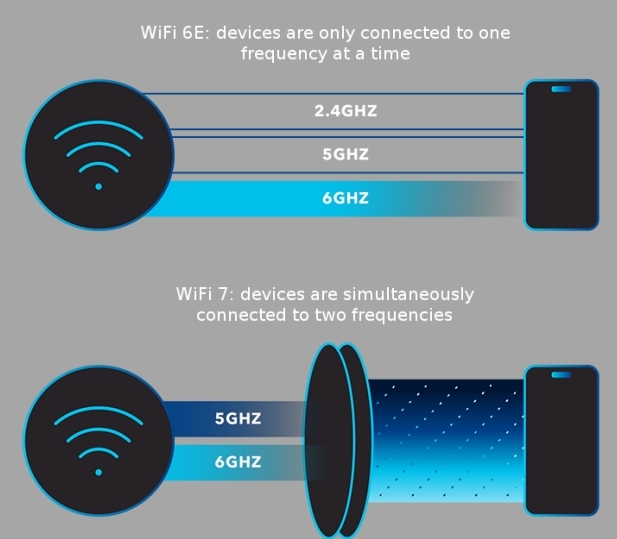Wi-Fi 7 Technology IPQ5332 vs. IPQ9574: Comparison of Core Chips for Industrial Routers

Industrial routers play a crucial role in modern IoT and enterprise networks, requiring high performance, stability, and versatility to adapt to various demanding application environments. As the core of industrial routers, the choice of System-on-Chip (SoC) directly determines the router's performance and functionality. This article will provide a detailed analysis of Qualcomm's IPQ5332 and IPQ9574, comparing their architectures, performance, features, and application scenarios.
1. Architecture and Manufacturing Process
IPQ5332 and IPQ9574 differ significantly in architecture and manufacturing process.
IPQ5332:
Architecture: Based on the ARM Cortex-A53 architecture, it is a mid-range processor that focuses on cost-effectiveness and energy efficiency.
Manufacturing Process: Utilizing a 28nm manufacturing process, this allows for a good balance between power consumption and cost.
Core Number and Frequency: Equipped with four Cortex-A53 cores, operating at a frequency of 1.4GHz.
IPQ9574:
Architecture: Based on a more advanced ARM Cortex-A73 architecture, it is a high-end processor designed for high-performance demand scenarios.
Manufacturing Process: Utilizing a 14nm manufacturing process, it brings higher energy efficiency and processing performance, while reducing power consumption.
Core Number and Frequency: With four Cortex-A73 cores, operating at a frequency of 2.2GHz, it significantly enhances computing power. In terms of architecture and manufacturing process, IPQ9574 undoubtedly has significant advantages, providing stronger processing power and higher energy efficiency, making it suitable for applications with high demands for computing performance and multi-tasking.
II. Wireless Communication Capabilities
Wireless communication capabilities are one of the important indicators for industrial router chips.
IPQ5332:
Wireless Standards: Supports Wi-Fi 5 (802.11ac) standard, providing a theoretical peak rate of up to 1.7 Gbps.
Antenna Configuration: Supports 2x2 MIMO configuration, suitable for wireless coverage needs in small to medium-sized industrial environments.
Frequency Band Support: Mainly supports 2.4 GHz and 5 GHz frequency bands.
IPQ9574:
Wireless Standards: Supports the latest Wi-Fi 7 (802.11be) standard, providing a theoretical rate of up to 11 Gbps, significantly enhancing data transmission capabilities.
Antenna Configuration: Supports 4x4 MIMO configuration, providing a wider coverage range and more stable signals.
Frequency Band Support: Comprehensively supports 2.4 GHz, 5 GHz, and 6 GHz frequency bands, especially suitable for high-density user environments and high-interference environments.
In terms of wireless communication capabilities, IPQ9574 not only supports more advanced Wi-Fi standards, but also provides more frequency band options and higher antenna configurations, making it suitable for large industrial scenarios and applications with high performance requirements. The interface and expansion capabilities determine the connectivity performance and compatibility with external devices of a router.
IPQ5332:
Ethernet port: Integrates a 2.5G Ethernet interface, supporting gigabit-class data transmission.
Expansion interface: Supports basic USB 3.0 and PCIe expansion, suitable for the connection needs of general industrial devices.
IPQ9574:
Ethernet port: Supports multiple 10G Ethernet ports and a 10G SFP port, providing support for high-speed wired connections.
Expansion interface: Provides multiple PCIe 4.0 channels, supporting high-speed storage, network acceleration cards, and other expansion devices.
IPQ9574 excels in interface and expansion capabilities, especially suitable for complex industrial applications that require diverse and high-speed connections.
IV. Application scenarios
Due to the different performance and function positioning of the two chips, they also have different emphases in actual application scenarios.
IPQ5332: Suitable for small and medium-sized enterprises or industrial environments, especially those with high requirements for cost-effectiveness. It can provide sufficient performance and functionality support for general IoT gateways, small industrial routers, and home automation systems.
IPQ9574: Aimed at industrial environments with high performance and reliability requirements, such as large manufacturing plants, data centers, and smart transportation systems. Its powerful processing capabilities, advanced wireless standard support, and rich expansion options make it an ideal choice for high-density, complex network environments.
V. Summary
In summary, the IPQ5332 and IPQ9574 differ significantly in architecture, wireless communication capabilities, interface expansion, and application scenarios. The IPQ5332 is suitable for cost-sensitive scenarios with moderate performance requirements, while the IPQ9574 is positioned for high-performance and high-expansion applications, especially in industrial fields where strict requirements are placed on managing multiple devices, high-speed transmission, and complex network environments.
Based on different specific needs, enterprises and developers can choose the most suitable chip to build industrial routers, thus finding the optimal balance between performance, cost, and functionality.








评论